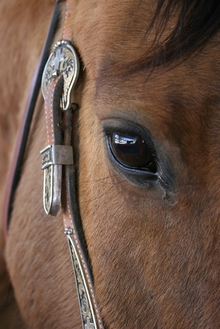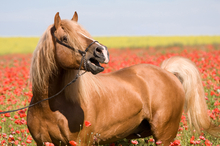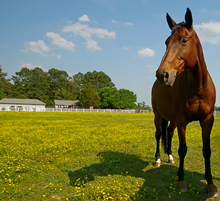Pay attention to those eyes!
A horse has large eyes with a wide field of vision that encompasses approximately 350 degrees, enabling it to see far out to each side, as well as what's behind it. Did you know that a horse can see a different sight with each eye? Is it any wonder that the horse is supersensitive to movement or surprises coming from any direction?

Horse eyes
Patient, calm and ready to learn. A soft eye is a good indictor of your horse's state of mind.
What's more, the horse uses the lower part of its retina to see objects at a distance and the upper part to see objects that are near it. When a horse raises its head, perks its ears, and brings both eyes together, it is looking straight ahead at something in the distance. Conversely, when the horse lowers its head and relaxes its eye muscles, it's looking at something closer.
What is often not realized is that a horse's binocular vision is rather limited when it is looking at something up close. Horses have a blind spot approximately four to five feet in front of them because vision is blocked by their long muzzle. That is why some horses have problems with jumps. The jump disappears into the blind spot, and unless the rider allows the horse to lower its head, it may either miss the jump or refuse to cooperate with the rider.
Horses will sometimes move quickly in the direction they are looking, and an observant rider will be prepared for changes in direction or sudden movement forward.
Paying attention to what your horse is doing with its eyes can provide valuable clues to its mental state and let you know when it is in its comfort zone or when you need to watch out for what will happen next. When the eyes are opened wide with the whites plainly visible, the horse is usually frightened or angry. When the eyes look hard, the horse is tense and often resistant or belligerent. When the horse is processing information or thinking, it usually blinks either slowly or rapidly, depending on whether or not any threat is sensed. Wrinkled eyes indicate that something is bothering the horse and causing it to worry. When the eyes are half-closed, the horse is relaxed, tired, or may be sleeping. When the eyes look soft and relaxed, the horse is in an acceptance and learning mode and will usually be very cooperative.
Watch those ears!
Have you ever noticed how your horse swivels its ears? No matter what the horse is doing: eating, drinking, dozing, or just leaning against the fence, the ears are always in play, monitoring the world and listening for that quiet sound that indicates danger is near.
Forward pointing erect ears indicate a horse that is focused on a distant object.
Physically, a horse's ears are built like a funnel with an exterior part that can twist and turn, capturing sound and conveying it into the ear canal for the horse's brain to process and make a quick decision about how to react. Although fight-or-flight is no longer the norm for the horse in a modern stable, try telling the horse that no packs of wild dogs or beasts of prey are lurking just around the corner. Instinct tells it differently.
Although horses use all their senses for communicating, a horse's ears are their most expressive features. As a creature of prey, hearing or recognizing the often subtle sounds of an approaching predator meant the difference between life and death. As a creature of prey, a horse had to be able to read the signals of other horses in the band to survive.
Awareness of the positions and movements of a horse's ears lets us know much about the horse's state of mind. With ears up and forward, the horse is often curious and relaxed. When the ears prick up sharply, the horse is alert and looking for something either frightening or interesting. Ears pinned backward indicate aggression. Alunge, bite, or kick may occur without further warning. When ears swivel more gently to the back or side, the horse is relaxed and listening to someone or something that creates a more mellow state of mind.
Listen to what comes out of that mouth!
Horses communicate with each other and with humans through a rather wide range of vocal signals. Combined with body posture, these vocalizations tell a great deal about the horse's mood and attitude.

Horse neighing
Stallions can be very vocal, and use their voice to control mares and warn intruders.
Like humans, horses often sigh. Some sighs are signs of pleasurable activity, such as when the horse is being groomed. Other sighs may be accompanied by a relaxation of muscles and a body shudder as the horse relaxes and gets comfortable. Other sighs indicate boredom and too little interesting activity, such as when a group of people stand around talking and the horse is being ignored.
Horses neigh and whinny to communicate with other horses, to greet them, or to let them know, "Hey I'm over here and would like company." When a high-pitched neigh is accompanied by an arched neck and pricked ears, the neigh conveys alertness to possible danger or excitement about something going on in the vicinity. If you are riding the horse when this happens, pay attention because the horse may bolt or come to a dead stand-still.
The soft, throaty sounds horses make, especially when greeting other horses or letting their presence be known, are referred to as "nickers." Nickers are signs of recognition and are more subdued than neighs because the horse's mouth is closed and the lips sealed. Horses often nicker when they see that feed is on the way or when a rider walks into the stall area and the horse wants attention.
Squeals -- especially high-pitched, loud squeals -- are threats and are often followed by striking out or bolting toward something or someone seen as a threat. A squeal is a sign to be very cautious and watch for what happens next.
Horses snort for several reasons, including clearing out their nostrils, expressing excitement, or as an indication that they want to go faster because they know good things are about to happen. Horses also have a sharp snort that signals an alert which is usually made obvious by the horse's posture.
The Tell-tale Tail.
Tail swishing has many uses. Horses swish their tails to keep flies and other insects off their skin. Rhythmic, slow swishing may indicate the horse is waiting patiently for something to happen and is in a submissive mode.
A swishing tail raised high usually means the horse is excited, attentive, and feeling good. When the raised tail is flagged, it may indicate a range of emotions, anything from happy and playful to excited or alarmed. When the tail is clamped closely to its buttocks, the horse is nervous or afraid and is hunkering down.
Of course, you will observe many variations on these signals that horses use among themselves and with their humans. By paying careful attention, you will learn to read your horse very well, and, in the process, the horse will most likely pick up on some clues about you and how you communicate.


